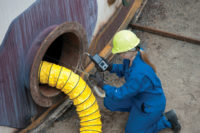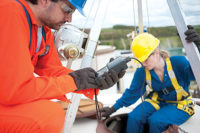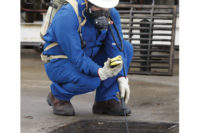
Confined space work has been around for a long time. The definitions have been repeated for years in articles like this one, quoting the OSHA regulations and picking apart every detail. If we are clear about how to work in confined spaces, then why are workers still getting hurt and killed? Some causes that come to mind are complacency, recklessness and indifference, but one has to believe that there is more to it.
Training and planning
While conducting a recent confined space training class, I surveyed attendees to see what they felt we were missing when dealing with confined space work. The “we” is anyone who might work in or around a confined space. The two top responses were “training” and “a proper rescue plan.” We discussed how the lack of both is a real danger when working in confined spaces and how these issues can and need to be addressed. OSHA’s Permit Confined Space Law 29 CFR 1910.146 addresses training requirements and states: “The employer shall provide training so that all employees whose work is regulated by this section acquire the understanding, knowledge and skills necessary for the safe performance of the duties assigned under this section.” Though these requirements have been read before, their call to action is somehow getting lost.
Practice makes a difference
Many good coaches have said, “Practice as you play, and play as you practice.” We need to apply this approach when training employees to work in confined spaces. If employees repeatedly practice the procedures set for how to work in this kind of environment, then the procedures eventually become a part of the company’s safety culture.
Training an employee to conduct work in a confined space can also be compared to training in the profession of firefighting. When we see firefighters on television, they do their jobs so well and often make it look easy. They quickly connect hoses to hydrants, place ladders on buildings and enter burning structures without hesitation to protect life and property. We forget that before they could do any of that, they spent several weeks, if not months, training at the academy. Then a young firefighter was paired up with an experienced firefighter for some time before given the freedom to do these tasks by himself or herself. Why all the preparation? Because it is dangerous work.
This same approach needs to be applied to working in and around confined spaces. We cannot put someone in harm’s way without proper training and expect nothing bad to happen. Every discipline surrounding confined spaces, including entry supervisors, authorized attendants, authorized entrants and rescue personnel, must train for the duties they will perform. In addition, they must work and train together because their safety is highly dependent upon their seamless interaction. An entrant in a confined space must have trust in the attendant who is there to keep him or her safe with trained and watchful eyes. Similarly, a firefighter entering a burning building must trust the pump and hydrant operators to keep the water supply coming
Rescue plan for the unexpected
But even with proper training and continuous preparation for the expected, the unexpected can still happen. Just as most people carry car insurance, those working in confined spaces should always have a plan should an accident occur. Having the proper rescue plan in place is the life insurance policy needed in confined spaces. Training on your rescue plan is necessary so that the rescue itself does not add to any problems but solves them. Per OSHA’s recommendations, you need to be aware of four basic levels of rescue when dealing with confined spaces: self rescue, non-entry rescue, entry rescue and technical rescue.
Self rescue requires a worker to wear a self-retracting line (SRL). If he slips, trips or misses a rung on a ladder, he can regain composure by gathering himself up, and the SRL will reset. The work can then proceed. An SRL would be used in the instance of a simple mishap that does not require the line to be sent out to be checked or reworked.
If a worker were to take a big fall and had to be winched out of a confined space, this would require a non-entry rescue. A non-entry rescue takes much more preparation, training and practice as the attendant is involved directly with the rescue. It is critical that he is fully aware of the dangers associated with removing someone from a confined space. He must also have complete knowledge of the rescue equipment. The ease at which a person works with his rescue equipment should be comparable to the ease at which a person operates his car. Why can people operate their cars so easily? Again, it’s the practice.
The next two levels of rescue, entry rescue and technical rescue, require more training and preparation than most people might imagine. Several people are involved, and more equipment is needed. Entry rescue requires that an attendant become an entrant - the original entrant is injured and has no way out of the confined space. A technical rescue is required when the person in the space is completely immobile, requiring far more assistance. These two types of rescue can be avoided by conducting ample pre-planning and training; however, they still might be necessary to use.
Regardless of exactly what we are missing when it comes to confined spaces, the reality is that people are still being hurt and killed in them. We must take every opportunity to increase safety and prevent accidents. This includes, but is not limited to, ensuring employees are prepared to work in confined spaces by providing proper training and a rescue plan. There are several ways a person can get the training they need and continuously practice the skills learned. Both classroom and field training are provided by many organizations, though the best training includes classroom and hands-on training. In these classes, attendees learn the confined space laws and hazards and are provided the opportunity to test learned skills in a confined space simulator. But even without a simulator, techniques can be practiced at nearly any facility. Like anything else - if you train properly, confined space work will go smoothly.





